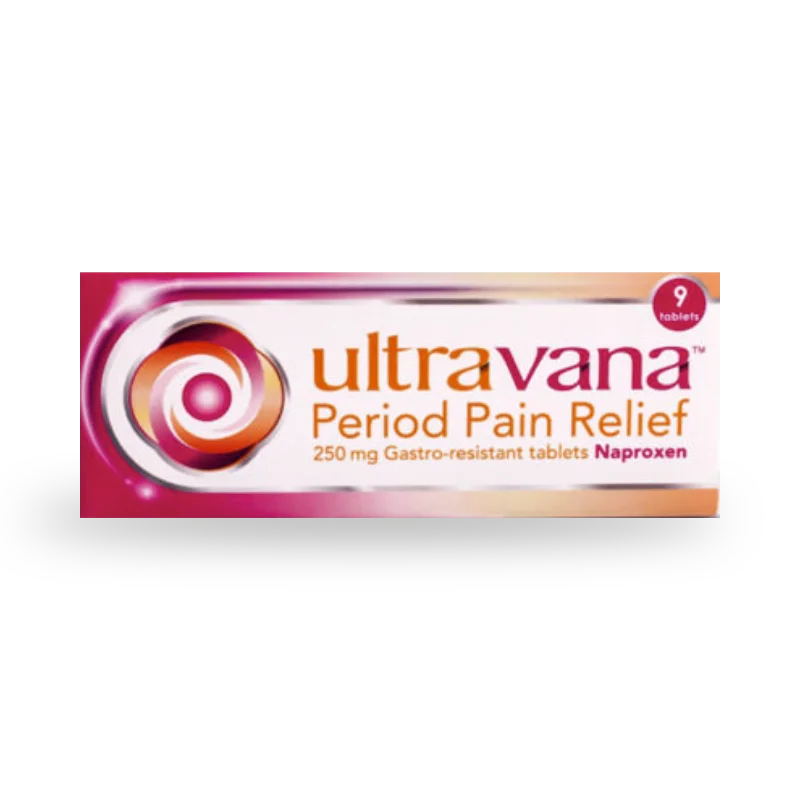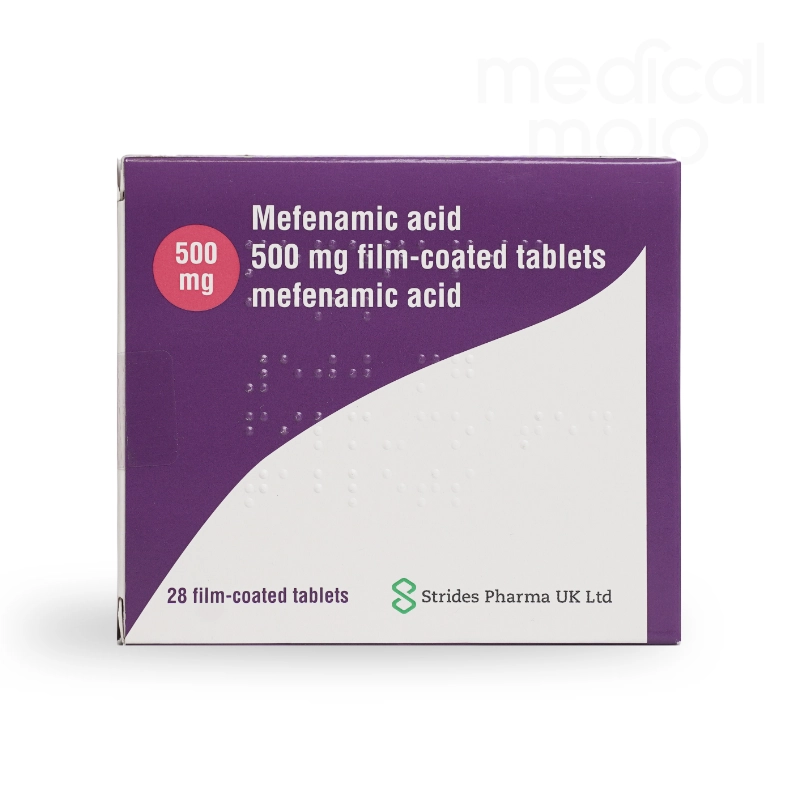Period pain
Prescription and over-the-counter remedies to stop Aunt Irma ruining your day
Powerful and effective pain relief from our range of prescription strength medicines.
Talk to our wellnes coaches to help you find long term strategies for dealing with PMS.
Find the right period pain treatment for you
View All ProductsWhat you should know about period pain or dysmenorrhoea
Period pain, also known as dysmenorrhoea, is caused by the muscular contractions of the uterus as it sheds its lining during menstruation. These contractions are triggered by the release of prostaglandins, which are chemicals in the body that make the uterine muscles tighten. Higher levels of prostaglandins are associated with more severe menstrual cramps.
While some discomfort during periods is normal, severe pain that interferes with daily activities is not. This could be a sign of an underlying condition such as endometriosis, fibroids, or pelvic inflammatory disease. If you experience severe pain, it’s important to consult with a healthcare provider.
Period pain can be relieved with over-the-counter pain relievers such as ibuprofen or paracetamol. Mefenamic acid, a prescription NSAID, is often preferred for more severe pain. Additionally, applying heat to the lower abdomen, exercising, and practicing relaxation techniques can help alleviate discomfort.
Mefenamic acid is a nonsteroidal anti-inflammatory drug (NSAID) that is particularly effective for treating period pain. It works by reducing the production of prostaglandins, which decreases the intensity of uterine contractions and reduces pain. It is often prescribed for short-term use during menstruation.
Yes, certain lifestyle changes can help manage period pain. Regular exercise, a healthy diet, staying hydrated, and practicing stress-relief techniques like yoga or meditation can reduce the severity of menstrual cramps. Avoiding caffeine, alcohol, and smoking can also help.
You should seek medical attention if your period pain is severe, lasts longer than usual, or if you experience other symptoms such as heavy bleeding, irregular periods, or pain that occurs at times other than during menstruation. These could be signs of an underlying condition that requires treatment.
For women with persistent period pain, long-term treatments may include hormonal contraceptives like the birth control pill, which can help regulate periods and reduce pain. In some cases, a healthcare provider may recommend a hormonal IUD, which can also lessen period pain and bleeding.
Yes, diet can influence period pain. A diet rich in fruits, vegetables, whole grains, and omega-3 fatty acids can help reduce inflammation and ease menstrual cramps. Reducing intake of processed foods, sugar, and caffeine may also help minimize discomfort during menstruation.
Additional information
What is period pain?
Visits from Aunt Irma can be a painful experience for some women, while others seem to breeze through with minimal sysmptoms. Period pain, also known as dysmenorrhea, refers to the cramping and discomfort that many women experience before and during their menstrual cycle. It is a common condition, with most women experiencing some degree of pain during their periods at some point in their lives. The intensity of period pain can vary greatly among women. For some, the pain comes in sharp, intense spasms, while others may experience a more constant, dull ache. Period pain usually coincides with the onset of menstruation and typically lasts between 48 to 72 hours. While period pain is usually mild, for some, it can be severe enough to interfere with daily activities, making it a significant concern that requires effective management.
Period pain, also known as primary dysmenorrhoea, is a common experience for most women at some point in their lives. This discomfort typically manifests as cramping sensations in the lower abdomen, which can sometimes radiate to the lower back and thighs.
What causes period pain?
Period pain is caused by the muscular contractions of the uterus (womb). During menstruation, these contractions become more forceful to help shed the uterine lining.
These stronger contractions can temporarily cut off the blood supply to the uterus by pressing against nearby blood vessels. This lack of oxygen triggers the release of pain-inducing chemicals in the tissue. Additionally, the body produces prostaglandins, which cause the uterine muscles to contract even more, further intensifying the pain.
In some cases, period pain can be linked to an underlying medical condition known as secondary dysmenorrhoea. Conditions that can cause secondary dysmenorrhoea include:
- Endometriosis: This occurs when the tissue that normally lines the uterus grows outside of it, typically on the ovaries or fallopian tubes, causing severe pain as it sheds.
- Pelvic Inflammatory Disease (PID): A bacterial infection that leads to inflammation of the uterus and other reproductive organs, often resulting in pain.
- Intrauterine Devices (IUDs): These contraceptive devices, made of plastic and copper, can sometimes contribute to period pain.
- Fibroids: Non-cancerous growths in the uterus that can lead to heavier, more painful periods.
The severity of period pain can differ significantly between women. Some may experience more intense pain due to higher levels of prostaglandins, which lead to stronger uterine contractions. The exact reason why some women produce more prostaglandins than others is not fully understood, but it is believed to play a key role in the intensity of period pain.
What are the symptoms of period pain?
The most common symptom of period pain is cramping in the lower abdomen. Other symptoms can include:
- Dull, throbbing, or sharp pain that can radiate to the lower back and thighs.
- Nausea and vomiting.
- Diarrhea or loose stools.
- Headaches and dizziness.
- Fatigue and general malaise.
These symptoms typically begin 1-2 days before menstruation and can last for the first few days of the period.
How to treat period pain
There are several ways to manage and treat period pain, ranging from lifestyle changes to medications:
- Over-the-Counter Pain Relievers: Nonsteroidal anti-inflammatory drugs (NSAIDs) like ibuprofen or aspirin are commonly used to relieve period pain by reducing the production of prostaglandins.
- Hormonal Contraceptives: Birth control pills, patches, or intrauterine devices (IUDs) can regulate or lighten periods, often reducing the severity of cramps.
- Heat Therapy: Applying a heating pad or hot water bottle to the lower abdomen can help relax the muscles and alleviate pain.
- Lifestyle Changes: Regular exercise, a healthy diet, and stress management techniques like yoga or meditation can help reduce period pain over time.
- Alternative Treatments: Acupuncture, dietary supplements like magnesium or omega-3 fatty acids, and herbal remedies like ginger or chamomile tea may offer relief for some women.
Why is the NSAID mefenamic acid preferred for period pain?
Mefenamic acid is often preferred for period pain (dysmenorrhoea) due to its specific effectiveness in reducing the symptoms associated with menstruation. Here are the key reasons why mefenamic acid is commonly chosen:
1. Targeted pain relief
Mefenamic acid is particularly effective in treating menstrual pain because it reduces the production of prostaglandins. Prostaglandins are chemicals in the body that cause the uterine muscles to contract, leading to the cramping and discomfort associated with periods. By inhibiting these chemicals, mefenamic acid directly addresses the cause of period pain, providing targeted relief.
2. Anti-inflammatory properties
As a nonsteroidal anti-inflammatory drug (NSAID), mefenamic acid not only alleviates pain but also reduces inflammation. This dual action is beneficial for women who experience both cramping and inflammation during their menstrual cycle.
3. Effectiveness in reducing heavy menstrual bleeding
Mefenamic acid has been shown to reduce menstrual bleeding in women with menorrhagia (heavy menstrual bleeding). This is an added benefit for women who experience both heavy bleeding and painful periods, as the medication can help manage both symptoms simultaneously.
4. Short-term use
Mefenamic acid is typically prescribed for short-term use during the menstrual period, usually for no more than three days. This short-term usage minimizes the risk of long-term side effects, making it a safer option for many women.
5. Well-tolerated
While all medications can have side effects, mefenamic acid is generally well-tolerated by most women when taken as prescribed. Its effectiveness and safety profile make it a popular choice for managing period pain.
6. Proven track record
Mefenamic acid has been widely used for decades as a treatment for period pain, with numerous studies and clinical experience supporting its efficacy and safety. This long history of use provides confidence in its effectiveness.
When to consider mefenamic acid
Mefenamic acid is particularly suitable for women who experience moderate to severe menstrual pain that is not adequately managed by over-the-counter pain relievers like ibuprofen or paracetamol. It is also a good option for women who experience heavy menstrual bleeding alongside their period pain.
However, it’s important to consult with a healthcare provider to ensure mefenamic acid is the right choice for you, especially if you have any underlying health conditions or are taking other medications.
How to prevent period pain
While period pain cannot always be completely prevented, certain strategies can help reduce its severity:
- Maintain a Healthy Lifestyle: Regular physical activity, a balanced diet, and adequate hydration can help manage pain.
- Avoid Caffeine and Alcohol: These can contribute to dehydration and exacerbate period pain.
- Practice Stress Management: Techniques like yoga, deep breathing exercises, and meditation can reduce stress levels, which may, in turn, help alleviate period pain.
- Consider Hormonal Contraceptives: If period pain is severe and persistent, hormonal contraceptives may be recommended to help regulate menstrual cycles and reduce pain.
When to seek medical attention
It’s important to seek medical advice if:
- Your period pain is so severe that it interferes with your daily life.
- Over-the-counter medications do not relieve your pain.
- You experience sudden or unusually severe pain.
- You have symptoms of a condition such as endometriosis, fibroids, or pelvic inflammatory disease.
- Your period pain begins later in life or suddenly worsens.
A healthcare professional can help diagnose the underlying cause of severe period pain and recommend appropriate treatments.
Buy online from Medical Mojo
At Medical Mojo, we offer a range of effective treatments for period pain, all prescribed by UK-registered prescribers. Whether you’re looking for over-the-counter pain relief, hormonal contraceptives, or other treatment options, our online pharmacy provides fast and discreet delivery straight to your door. Shop with confidence, knowing that our products are safe, effective, and approved by qualified healthcare professionals. Take control of your period pain today with Medical Mojo.
BSc Pharmacy, Independent Prescriber, PgDip Endocrinology, MSc Endocrinology, PgDip Infectious Diseases
Superintendant Pharmacist, Independent Prescriber
MPharm, Independent Prescriber. Registered cupping therapist.
Independent prescriber





